Honey Fungus – Identification, Edibility, Distribution, Ecological Role
Honey fungus suffers from a bad reputation as a virulent parasite of trees, but I admire it as a remarkable and ecologically important organism that also happens to be super-abundant and delicious.
A number of Armillaria species are generally referred to as “honey fungus” (see below), and most of them are not aggressive or problematic parasites. In healthy, diverse ecosystems honey fungus can be viewed as an important species – perhaps an apex predator, that culls old and infirm trees, opening up new opportunities on the forest floor, and breaking down wood that provides food for successive fungi and invertebrates, and ultimately building soils.
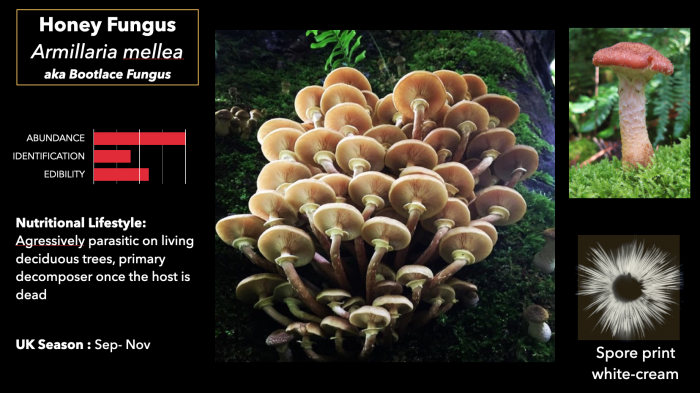
Graphic ©GallowayWildFoods
Honey fungus is best thought of as a ‘species complex’, comprising a number of species, subspecies and phenotypes. Recent advances in mycology and DNA sequencing means that what was previously considered to be one variable species has now been split into to over 30 species in the Armillaria genus. Many of these are indistinguishable unless you are a trained mycologist with a good microscope. More easily distinguished species in the UK include:
- Armillaria mellea – Honey fungus. Common in South of UK, rare in the North. A virulent parasite then saprobic on killed tissue. Rhizomorphs are flattened.
- Armillaria gallica – Bulbous honey fungus. Similar to A.mellea, only with a less distinct ring and bulbous stem base, only weakly parasitic, then saprobic. Locally abundant where established – more common in Scotland than A.mellea. Rounded rhizomorphs.
- Armillaria ostaye – Dark honey fungus. Similar to A.mellea, but darker capped, often greyish, and with a whitish double ring with distinctive dark brown or black scales on its underside that persist as the mushroom matures. Most often (but n to exclusively) found with conifers, uncommon in the UK.
- Armillaria tabescens – Ringless honey fungus. Similar to A.mellea, only lacking a ring on the stipe, more common in South UK.
Honey fungus is sometimes referred to as bootlace fungus, in reference to its thick, black rhizomorphs (see below)
Honey Fungus Identification – 2/5
Honey fungus grows fast and as it does its form, colours and textures change rapidly. This makes confident identification potentially challenging for anyone new to mushroom identification. In addition, its substrate can be buried, so it may appear to grow from the ground rather than from trees. This can be misleading as many sources describe it as if it only grows from trees. This combination of factors, as well as its abundance, make it – by some way – the mushroom I receive most identification enquiries about.
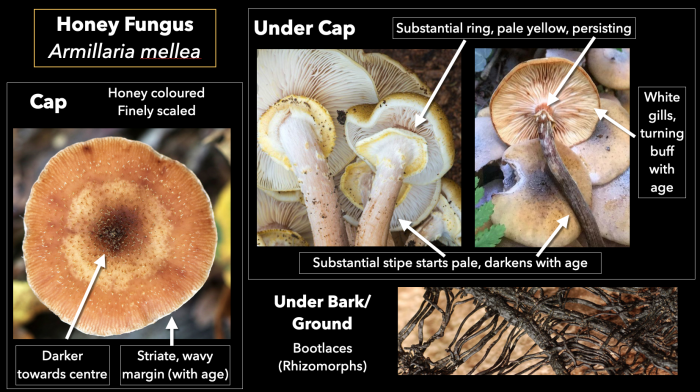
Some key identification features of honey fungus (Armillaria mellea). This image is taken from my webinar on Mushroom Identification, where honey fungus is discussed at length. Graphic ©GallowayWildFoods.com
Cap: Forming as small round buttons, growing quickly to 5 to 15cm in diameter when fully opened; colour is most typically honey-yellow but can also be reddish-brown and various shades in-between; a consistent feature on all but the oldest, most washed-out specimens is a darker area near the centre which is made up of densely packed scales that are darker than the rest of the cap. Inside, the cap flesh is white and firm. Forming as deeply convex button shapes, the caps rapidly flatten and may even become concave (upturned), and develop wavy, striate margins as they grow.

Honey fungus (A.mellea) caps. The darker tones and greater density of fine scales towards the centre are a distinctive feature. Image ©GallowayWildFoods
Gills: Initially covered by a solid protective pale yellow veil which quickly becomes a substantial ring on the stem as the cap grows. This exposes off-white gills, which quickly become pale flesh coloured then gradually darken with age, often developing dark rusty spots as they reach maturity. The gills are adnate (broadly attached to the stipe), sometimes slightly decurrent (running down the stipe). See my An Introduction to Fungi post for a discussion of different gill shapes and attachments. Spore colour is white.

As the caps tend to overlap, it is sometimes possible to observe natural spore prints on the cap below – this white powdery frosting you see in this photo, which also shows how the stipe can darken to almost black with age. I wouldn’t eat honey fungus at this stage as the gills have turned from white to buff and are developing darker blotches. Image ©GallowayWildFoods
Stipe (Stem): Chunky and solid compared to the size of the cap, especially when young – to me it seems that honey fungus feed so well on their tree victims that they can afford to be quite profligate in the proportions of their stipes! The stipe is pale at first, darkening through flesh coloured, brown then nearly black. It often has scales and later a somewhat wooly or felty in texture. 5 to 15mm in diameter and 6 to 15cm tall. To differentiate dark honey fungus (Armillaria ostoyae) from Armillaria mellea, look for whitish double ring with distinctive dark brown or black scales on its underside that persist as the mushroom matures. As the name suggests, ringless honey fungus (A.tabescens) lacks a ring altogether.
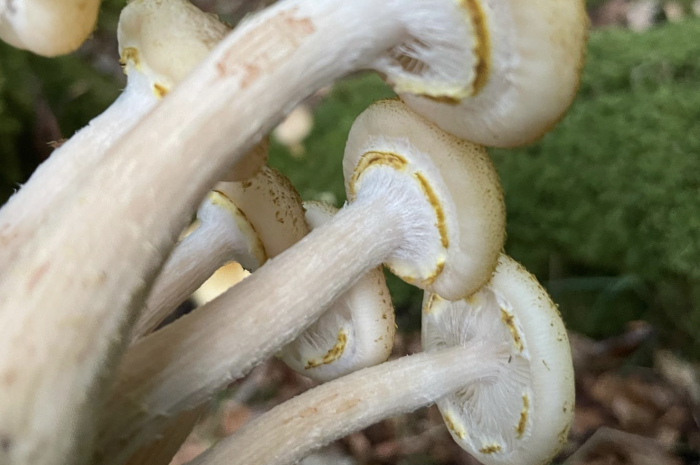
Honey fungus (A. mellea) stipes with veil/ring still attached to the cap. This protects the gills until they are ready to drop spores. Image ©GallowayWildFoods
Flesh: Firm and pale in both cap and stipe, without much odour. Tastes acidic raw, though you should be sure to eliminate the funeral bell from your enquiries before tasting – see here for a discussion around using taste to help identify some mushrooms. More on lookalikes below.
Rhizomorphs: Honey fungus grows from thick, bootlace-like networks called rhizomorphs that can be easily seen with the naked eye. Individual strands are shiny licorice-black (or occasionally very deep red), usually about 2mm wide, but they often coalesce into even broader strands. These afford protection for fragile hyphae – the building blocks of mycelium – by use of a melanin. Armillaria mellea forms flattened rhizomorphs, while in other forms of honey fungus they can be more rounded in cross section. Look for them under the bark of dead and dying trees, where they form complex circuitry. This is a good way to get some sense of the complexity of mycelium without having to use a microscope – imagine comparably complex networks on a microscopic scale and you’ll have some inkling of the dense entanglements of fungi. Rhizomorphs are tough and strong by mycelial standards, allowing honey fungus to travel through soil for many metres to reach new food sources.

Look under the bark of dead trees to see honey fungus rhizomorphs. Their dense circuitry gives some idea of the complexity of mycelium at the microscopic scale. Image ©GallowayWildFoods
Bioluminescence: The gills of honey fungus can glow faintly in the dark, but this is hard to see with the naked eye. What is easier to observe is its bioluminescent mycelium (but not its rhizomorphs). By breaking open a piece of heavily infected wood, and with your eyes fully adjusted to the dark, it is possible to see it glowing! This phenomenon has traditionally been referred to as foxfire, possibly derived from folks – the old English name for fairies. (Incidentally, this is how the plant foxglove (Digitalis purpurea) got its name – from folks (fairies) gleiss (bells)!). Its not known if or how glowing in the dark might be useful to fungi (nor is there any definitive theory on why fungi are the colours they are). Perhaps it helps to attract nocturnal insects that play a role in spore dispersal? Its also possible that its a random outcome of some other chemical trait that is selectively neutral. Or perhaps they are just showing off! I like things that science hasn’t got around to working it out – these are the gaps where imagination can shine in!
Honey fungus lookalikes
Its wise to be extra careful when harvesting honey fungus as food, as the deadly poisonous funeral bell (Galerina marinata) is another brown-capped, ringed mushroom that grows in trooping clusters from trees. Although to experienced foragers it is only superficially similar, novices can feel quite daunted until they nail down positive identifications of both.
My post on funeral bells also includes details of another brown mushroom that grows in trooping clusters on trees – the sheathed woodtuft (Kuehneromyces mutabilis). It too is quite easily distinguished by sensible close observation, and is edible.
Perhaps more similar to honey fungus is the shaggy scalycap (Pholiota squarrosa), which has similar proportions, colours, growth habit and substrate, and might give you a tummy upset. It is distinguished by being very scaly all over – to the point of being shaggy looking – and having darker gills and and a brown rather than white spore print.

Comparison of honey fungus with funeral bell and shaggy scalycap. Graphic ©GallowayWIldFoods.com – from my Wild Mushrooms Identification webinar. Graphic ©GallowayWildFoods
Another potential lookalike for honey fungus is velvet shank (Flammulina velutipes). I say “lookalike” only because it can be similarly coloured and grows in trooping clusters from trees, but really its quite different, having no ring, a slimy rather than scaly cap, and growing a good bit later in the year. Read all about it here.
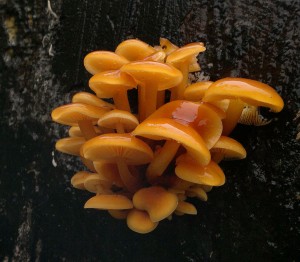
Velvet Shank – not really like honey fungus at all if you look carefully! Image ©GallowayWildFoods
Honey Fungus Edibility – 3/5
Young caps of of all varieties of honey fungus are delicious, and have a long history of being eaten as food. In a blind tasting I’ve done with chefs they regularly outscored many more highly prized mushrooms with their firm texture and rich, rounded flavour. I have lowered my rating of their edibility from 4 to 3 because they can be digestively challenging to some people.
How To Prepare Honey Fungus
Here is my advice if you want to try eating honey fungus:
Discard the stipes – they tend to be tough and harder to digest than the caps, so I recommend you only eat the caps (stipes can be added to stock pots for flavour, then discarded, or dried and powdered to use in stock mixes).
Eat only young caps – I only harvest them when the gills are still white, or only just turned flesh coloured. As they darken the mushroom will become more bitter and harder to digest. Basically, the younger the better – and as you’ll see below, unlike some other mushrooms, there are no sustainability issues around harvesting lots of very young honey fungus.
Always cook thoroughly – Some sources recommend always boiling caps in water and discarding the water before using them in recipes. In areas of Poland they are boiled for 30 minutes, which seems a little excessive to me (long cooking times for mushrooms are not unusual in East European cuisine – I still recall the looks of shock on the faces of a group of Ukranians when I simply fried a load of chanterelles at the end of a guided walk – they had never eaten a mushroom cooked for less than 1 hour!). A few minutes in salted water on a rolling boil, then strained and rinsed before frying is quite sufficient for all but the most delicate constitutions and probably isn’t a bad policy first time you try them, but I personally don’t think it is necessary once you have established that you “get on” with honey fungus. Provided the caps are young and tender, adding them straight to the frying pan and cooking thoroughly works fine for me – but you should find your own way.
Boiling then cooking in other ways can seem a bit excessive to those used to cooking al denté vegetables, but the cell walls of fungi are made of chitin, which does not break down in the same way as plant based compounds, so boiling combined with extended cooking periods does not render your mushroom mush! If you’ve ever added button mushrooms to a slow cooker at the same time as diced vegetables you can experience the difference – an hour or two later the mushrooms will still be mushroom shaped and textured, while the the vegetables will be mushy.
When pickling honey fungus they do not need to be pre-boiled. Simmering in the pickling solution is adequate, after which you can discard the pickling solution and preserve them under oil. See here for a detailed exploration of pickling honey fungus and other mushrooms.
Make sure you get on with them – Most people get on with and enjoy well cooked honey fungus, but a proportion may suffer gastric discomfort, even if they eat it well cooked. As with all wild mushrooms, the first time you try it eat only a small amount (eg. 1 cap) well cooked (eg. thoroughly fried, or boiled in water for 5 minutes, then fried), and don’t consume other mushrooms that are new to you at the same time (because if you react you won’t know what you are reacting to!). Wait until 24 hours after consumption and if you haven’t had any gastric discomfort, you can up your serving next time round. Many people are put off by this warning and that is fair enough. But personally I think the possibility of a few hours of mild discomfort is a very small price to pay for the possibility of adding this tasty, abundant mushroom to your larder.
Be cautious: As honey fungus digestibility can vary according to species, subspecies, phenotype, what it is feeding on, and the age of the mushroom itself, I don’t recommend serving them to large groups or in restaurants. Its one of those mushrooms to develop your own relationship with, and to eat with knowing friends and family.
Consider species and substrate variation: As honey fungus is quite variable within and between species (which most foragers will struggle to distinguish from one another), and may have slightly different chemical characteristics according to what age and type of wood it is growing from, it is worth getting to know your local colonies, and perhaps taking extra care when harvesting them from different locations
Honey Fungus Recipes and Preservation Ideas
With all that in mind, i’d urge you to connect with these super-abundant and delicious mushrooms. If you hit their main surge of growth you can harvest vast quantities of them in small areas in no time at all! They grow very quickly and their period of perfection in any given region may be under a week. Fortunately honey fungus is versatile – great for frying, sautéing adding to soups, sauces, stews or paté, so you can really gorge on it when it surges.
The caps don’t keep particularly well and are best used within a couple of days of harvesting. Its worth being primed and ready to preserve them when the glut arrives! Caps are best preserved by pickling or cook-freezing, but don’t dry terribly well, losing their attractive texture.
One of my favourite ways to eat them is to sauté them with chopped shallots for 5 minutes, then add madeira, reduce and finish with cream or creme fraiche. This is great on toast or as a sauce for with pasta or meat.
Honey Fungus – UK Distribution – 5/5
Honey fungus is one of our most commonly occurring and abundant wild mushrooms across the UK. It appears in enormous quantities most years, and seldom seems to have a bad year.
Honey Fungus – Habitat
With the exception of dark honey fungus, A. ostaye (which prefers conifers), all forms of honey fungus found in the UK almost always grow from living and dead deciduous trees.
They appear as trooping clusters from:
- Living, dying or dead standing trees
- Fallen trees (often those they have killed) and branches
- Old stumps
- Rhizomorphs and tree root networks that may have no obvious above ground parts. This can be confusing, as it looks like the mushrooms are just growing from the ground and many sources don’t mention this possibility.
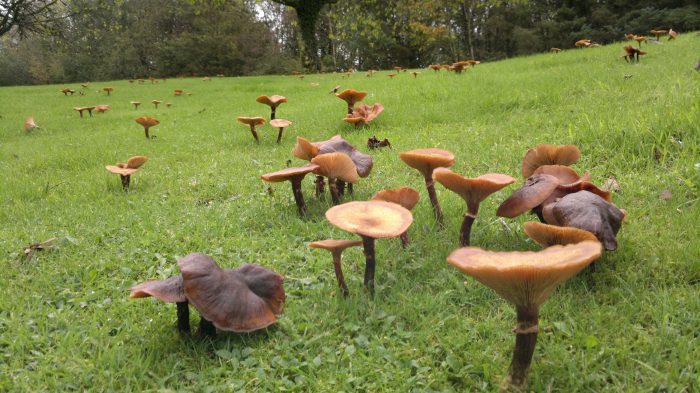
Old honey fungus growing from roots buried beneath a lawn. Note that the nearest visible tree may be some distance away.
Honey Fungus – Season: August to November
Honey fungus tends to appear in a large, rapid, localised surges. Where I live In SW Scotland this surge tends to come between mid~September and the start of October. Its likely to be later in the South of England.
Given we are only really interested in eating young caps when their gills are still pale, this can mean a harvesting season a short as a week for any one colony.
Honey Fungus – Ecological Role
Honey fungus is a parasitic plant pathogen and saprophyte, though the aggressiveness of their parasitism depends on which species you have (see above), and is often greatly exaggerated in the UK. This means that it feeds on living trees, and then continues to feed from them once they are dead. It causes a white rot, breaking down the lignin that makes wood hard and strong, leaving it soft and pulpy.
Its probing, searching rhizomorphs are the chief means by which honey fungus spreads, and it has been reported that these can grow up to 50 metres between food sources. This allows genetically distinct networks to cover vast areas of forest. I suspect a large forest near my house sprouts with genetically identical honey fungus across its length each year, though it would take some complex scientific analysis to confirm this. Mycologists have undertaken such work in the U.S. and discovered a network of dark honey fungus in Eastern Oregon that is now thought to be the largest single organism on earth, covering 900 hectares (2,200 acres or 3.4 square miles or about 1,665 football fields).
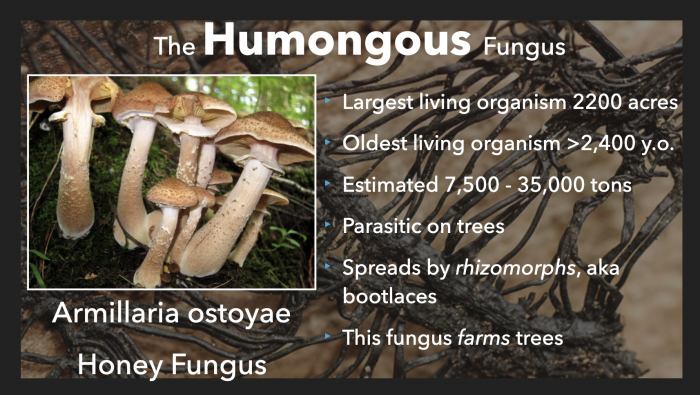
I discuss the humungous fungus in my webinar “Understanding Fungi”. Graphic ©GallowayWildFoods
Estimated to be between 2,400 and 8,000 years old, the humungous fungus may also be one of our oldest living organisms. In reaching such an age it has devoured many generations of trees, returning their nutrients to the soil to nourish new generations of tree. I like to think of it a highly successful “tree farmer”!
The humungous fungus has become something of a poster girl for mycology, receiving lots of press attention and illuminating the fascinating world of fungi for new audiences. There is a good article about the story of the research and fungal celebrity here.
Celebrity super-fungi aside, humans can be quite squeamish about parasitism, and tend to have a view of nature that admires trees and is suspicious of fungi. For these reasons, honey fungus has become enemy number one for many gardeners, fruit growers and foresters.
But as we start to understand more about the incredible complexity of forest ecosystems, even the more aggressive species of honey fungus can be seen rather more as apex predators: culling the the old and infirm, thinning herds (of trees!), opening up opportunities for renewal by creating space in crowded canopies. Most species in the UK are only weakly parasitic on already compromised trees and operate chiefly as saprophytes, breaking down dead wood and returning nutrients to the soil to nourish future generations of trees.
It is entirely understandable that people managing a few prized trees in their garden, an old fruit orchard, or a plantation might fear the more aggressively parasitic strains of honey fungus. Monocultures, or habitats built around just a few trees of similar age, can suffer significant losses over relatively short periods of time.
But honey fungus is endemic in all the healthy deciduous forests around me. I’d suggest that far from being catastrophic, honey fungus is an important contributor to their health and diversity. Even on a purely mycological level, it opens up new food sources for a succession of other fungi. I think of it as a primary predator, comparable in some ways to, say, a lion on the savannah. It selects a weak victim, kills it, eats its fill, then moves on leaving nourishment and habitat for many other species.
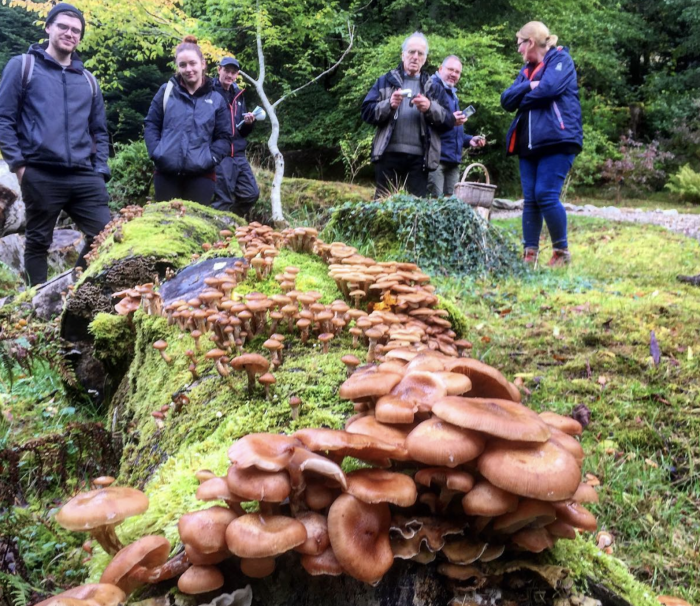
Honey fungus growing from a fallen beech tree. It is likely that the honey fungus killed the tree. I’ve visited this tree for many years. After the honey fungus stopped “fruiting” it was populated by a succession of other saprophytic fungi. Image ©GallowayWildFoods
Some strains of honey fungus (notably A. ostaye) have been found to have a higher and more rapid “kill rate” v younger trees, but are less destructive v older, well established trees. I know oak trees that have had bulbous honey fungus growing on them for over 20 years and are still doing OK, so its by no means an instant death sentence as some might have you believe. It is likely that other more mildly parasitic fungus will help their tree hosts resist honey fungus. In an oak wood near me where honey fungus is prolific, the oldest tree in the woods seems to be protected by hen of the woods (Grifola frondosa) Read more about this here).
Honey Fungus – Sustainable and Considerate Harvesting
Given it destructive reputation and abundance, its enticing to think we can – and perhaps should – harvest as much as we find of honey fungus for the pot. On the other hand if you accept it as an important keystone species, you might feel it should be treated in the same way as less abundant fungi that play important roles in our forests.
But the picture is even more complicated than it seems. You most certainly don’t want to be inadvertently introducing any of the aggressively parasitic honey fungus species to your garden, and its probably best if it is left to colonise new sites without human help. You might even be tempted to think of treating it a bit like some non-native invasive species such as japanese knotweed or ground elder – taking active precautions not to spread its spores to, say, your garden.
You needn’t get too paranoid about inadvertently introducing honey fungus to your garden as it seems that, despite being incredibly prolific producers of mushrooms, most types of honey fungus spread to new hosts primarily through their searching rhizomorphs rather than through airborne dispersal of spores via their reproductive structures. According to this excellent article, there is indirect evidence that airborne spores primarily germinate on old stumps trees that are wounded or sick already , especially in moist climates. Just like those lions thinning the wildebeest herd!
My policy is to harvest as much honey fungus as I like. In our valley alone I estimate each year thousands of tons of honey fungus grows and rots each year, so it seems really daft to be buying hot-housed air miles fungi. While harvesting and processing it I am careful (but not obsessive) about not introducing spores to new areas. This means carrying them in bags or tubs rather than a basket, and not disposing of trimmings in our compost, or strewing them about ther woods and garden as I might do to encourage other fungi.
For so many reasons, I’m very glad to have honey fungus around our valley. 🙂
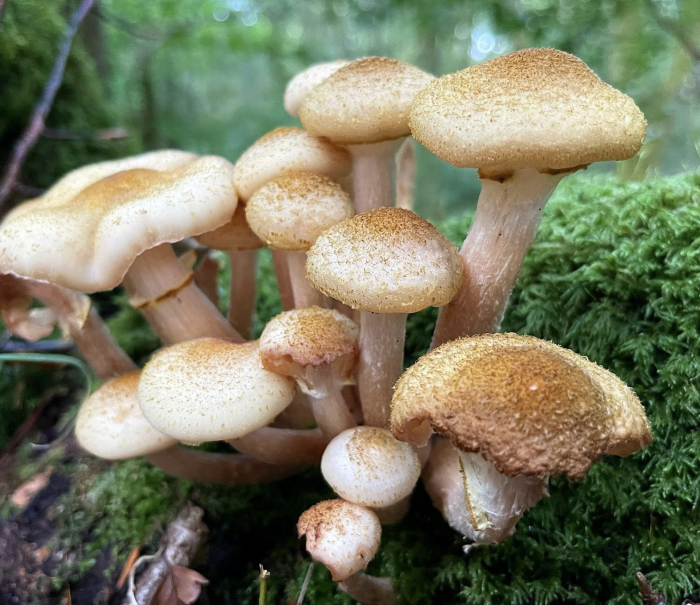
Young honey fungus growing in a typical tuft. ©GallowayWildFoods.com
Related Pages:
- An Introduction to Fungi Foraging
- How to pickle wild mushrooms
- Mushrooms Webinars
- Edible Wild Fungi Guide
- Guided Fungi Forays with Galloway Wild Foods